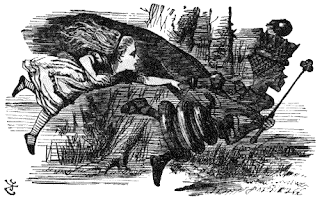… in the Minneapolis Star Tribune notes that the most charitable description of what’s been going on at the clubby University of Minnesota medical school would be “bizarre.”
Monday, November 8, 2010
“It takes all the running you can do to keep in place!”
Perverse Price Incentives in
Higher Ed
and the Red Queen Effect
This post is a very important one for helping to understand the tuition/loan rat race and the mess it has led to...
President Bruininks - and your successor - please pay attention.
The university president I worked for had a colorful way of framing the problem. He would remind his administrative colleagues, “We don’t want to leave money sitting on the table.” What he meant was that if families could possibly pay more to attend our university, our duty was to capture that increment. A prime consideration was to make sure that those students eligible to get federal grants and to take out federally guaranteed student loans maxed out on these. If they didn’t, we were “leaving money on the table."
It is not hard to extrapolate from this to what happened and what still happens when the federal government increases the funds in a student grant or loan program, or lowers the conditions of eligibility, or otherwise acts to make college “more affordable.” In college and university administrative offices across the country, people start to calculate just how high they will now be able to set new prices to capture these additional resources. Mentioning this in the company of higher education’s official representatives, of course, elicits indignation. Perhaps somewhere there are college administrators so conniving that they would do such a thing, but not us. We are concerned primarily about maintaining access and affordability. Those increases in federal aid mean that students who could not otherwise attend college now will have that precious opportunity. They will have access because the government has helped make college more affordable.
Well, if you say so.
There is a paradox in government subsidies for higher education. Government subsidies for most goods tend to spur increases in supply and bring new competitors to the marketplace, and thus work to reduce prices. But government subsidies in higher education seem only to increase prices. That happens because American higher education is arranged in a fashion that makes it extremely difficult for new competitors to enter the field. When the federal government chooses to subsidize ethanol, more farmers plant corn in more fields. When the federal government subsidizes students, the number of colleges and universities remained basically static.I don’t want to be overly cynical about federal aid to students. I am sure that many of the politicians of both parties who over the years have favored increases in student aid imagined they were (mostly) helping students. And I have no doubt that college and universities administrators mostly see themselves as altruists whose pursuit of more income for their institutions is bound tightly to their commitment to use some of that income to fund scholarships for needy students. But benevolent motives aside, the system works very much like a treadmill. [The Red Queen Effect] No matter how fast we run, we stay in one place. Increasing student aid doesn’t make college more affordable; it just puts more resources in the hands of college administrators.Our current system of higher education in the United States is so deeply enmeshed with the federal student aid system that it is difficult to see how we could ever get off the treadmill. Treadmills, however, don’t run forever, and this one is showing its age. We need to give some serious thought to developing new federal policies that can sustain the crucial parts of American higher education while eliminating the perverse incentives to higher prices.
Subscribe to:
Post Comments (Atom)





No comments:
Post a Comment